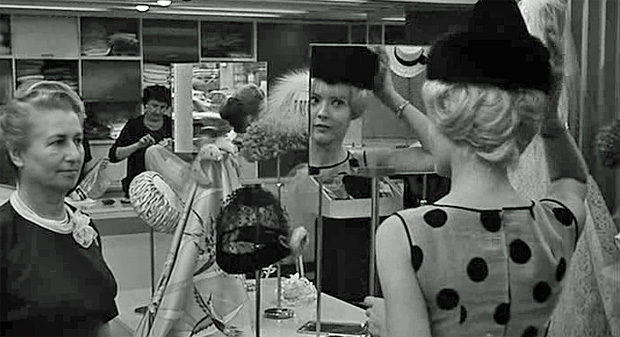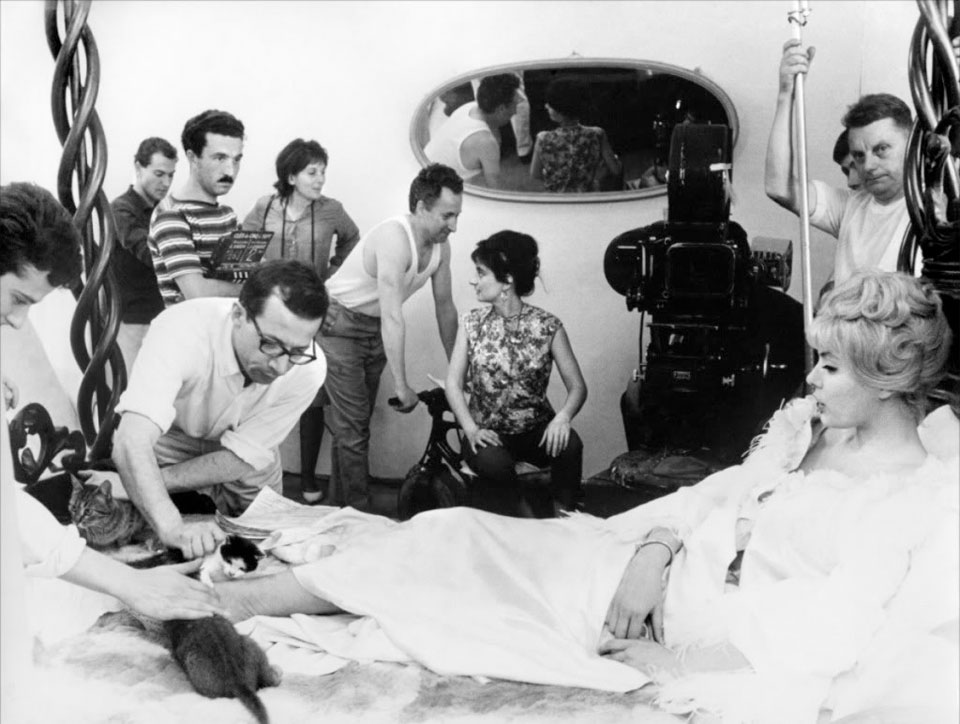Honorary Oscars: Agnès Varda's Cléo from 5 to 7
 Monday, November 6, 2017 at 5:00PM
Monday, November 6, 2017 at 5:00PM We're revisiting work from this year's Honorary Oscar winners. Here's Salim on Agnès Varda...
 What's good?
What's good?
When most people look back on the French New Wave, it’s unconsciously seen as a boys’ club, especially of the Cahiers du Cinéma clan with Godard and Truffaut. That’s unfortunate when a chapter in film history feels marginalizing and the masculinity in the French New Wave movement can end up nondescript.Much thanks for Agnès Varda then, representing both the literary Left Bank wing of the French New Wave and the feminine voice she brought to the fray.
While her directorial debut La Pointe Courte predates and even informs much of the French New Wave proper, Cléo from 5 to 7 is essentially the work that broke that glass ceiling and introduced a new sort of perspective into the one of the most radical movements in film history.

And the brilliant thing is how unassuming Cléo from 5 to 7 is about these things. Not TOO relaxed, mind you...
After all, it IS a tense waiting game the titular pop star (Corinne Marchand) has to suffer through before finding out whether or not she has cancer, but it’s unassuming about its own inherent politics. Sure, the then-current affair of the Algerian War is present like most French pictures of that era, yet only as a backdrop for Cléo’s exploration of what her imminent question of mortality mirrors the question of the life and identity she may lose. Cléo from 5 to 7 doesn’t structure itself as a series of existential questions either, it’s just a series of events and appointments Cléo must entertain during her wait for the medical results.
How she attempts to distract herself is by shallow attempts at leisure: shopping for hats (under the assumption that since “death is ugly”, she can stay alive as long as she remains beautiful), rehearsing with her songwriter (played by the wonderful composer Michel Legrand), meeting with friends at the movie theater they work at. And then there’s the unfortunate way those distractions fail: she purchases a black hat, the song she rehearses is dark and tragic, the movie her friends show her poke fun at the expense of a young girl. Certainly a picture that opens with a tarot reading and frequently has Cléo and her loyal assistant Angèle (Dominique Davray) reciting superstitions in alarm when they encounter them probably doesn’t think much of explaining these things away as coincidence. Death and fear stalk her everywhere and when she expresses the existential anxiety the tests put her under, her well-meaning acquaintances dismiss it or treat it as a joke before leaving her just as quickly as they arrived. Even if Varda doesn’t call attention to it, reading into her vanity as a psychological anchor to cope with the stress of her ailment or the lack of concern for her from others labeling her apprehension as performative starts getting gendered very quickly when you poke and prod at it, especially in the demand for her to play lover and singer and customer in highly feminine ways.
That sounds a lot heavier than enjoyable and Cléo herself is certainly not having a great time as Marchand plays her with a delicate melancholy, but Cléo from 5 to 7 is not a depressed movie. It is only a conscious one. Even before the final act entrance of soldier Antoine (Antoine Bourseiller), who makes for a philosophical foil to Cléo as they arrange to accompany each other to Cléo’s prognosis and then to Antoine’s shipment to Algeria, the movie slowly relaxes itself from its initially alarmed tone (at the opening tarot reading) to a more observational attitude towards Cléo and the people around her.

Varda indulges in two methods that ground the tale enough so it can feel lively without undercutting Cléo’s gloom. One is the use of on-location crowds in the 14th Arrondissement that surround Cléo with the implication of their own stories outside of her headspace, such as the taxi driver that takes her from the hat shop to her home or the scene of an apparently violent death next to a mirror. It’s a busy location, certainly one with a personality that Varda knows well and wants to display. And as Cléo comes more and more to terms with herself, the backgrounds get softer and more serene until the pleasant park where she meets Antoine and the movie takes a rest from its journey.
The other is the real-time pacing of Cléo’s waiting game, which allows Varda to indulge in her own array of formal tricks such as repeated shots and jump cuts in order to re-calibrate the film and Cléo herself with the now every time she lets her head slip away (or more literally, Varda allows the long takes to get ahead of itself. The jump cuts accentuate the long takes and vice versa). Cléo’s perception of time is Varda’s plaything, but Varda doesn’t have any ill will towards Cléo and doesn’t just use editing to help us sympathize with her pressures. Without spoiling it (though one could probably guess based on looking at the title of the film and the runtime), the final scene at the hospital is the closest the narrative comes to pulling the rug out from under us in our expectations of the film’s structure but Varda’s also too amiable not to reassure us before the film’s end.

By that point, Varda’s not only provided a sketch of one of the fullest female characters in the whole of the French New Wave but a whole location in the streets and parks she walked and different contexts to look at Cléo or the 14th Arrondissement. And in the space of an hour and a half, she proved to be a new perspective that movement could do with more of and film history is so much better for it.

Previously: Agnes Varda's The Gleaners and I, Donald Sutherland and Casanova, Charles Burnett's Killer of Sheep



Reader Comments (5)
an incredible film; love it
Cleo from 5 to 7 is gorgeous. I've seen a few films that she did but man, she is a true master at her craft.
As much as the French new Wave felt like a boys club and indeed more or less was a boys club, it's worth pointing out that they still created a lot of amazing, complex, iconic female protagonists. (I mean, Moreau and Karina alone have over a dozen between them.)
On the other hand the boys club that was the American new Wave (Scorsese, Coppola et all) of the 70s pretty much completely wiped out the female perspective from American cinema and it basically hasn't recovered its place since. (But yes, internet, please continue fixating on woody Allen and inventing evidence that he is the real misogynist.)
Back to Varda however - Cleo from 5 to 7 is indeed a wonderfully relaxed yet revelatory near-masterpiece that at the very least belongs in the same conversation as Breathless and Jules and Jim and Bande a part and Vivre sa vie.
With the world very much bent on rediscovering unfairly neglected female voices I'm sure Cleo's reputation will continue to rise and rise.
Thanks for your review. I love this movie...watched it during my school years TWICE!
@Goran - So, I almost added a post-script in the comments to mention Marguerite Duras' screenplay for Hiroshima Mon Amour to point out that, despite it being directed by Alain Resnais, the French New Wave before 1962 wasn't entirely overcrowded with masculine voices. But then that's the only movie in the movement until Cleo to have a major female creative force.
Beyond that, while I can at least say that directors like Godard, Demy, Resnais, Truffaut, and Rohmer all had some legitimate interests in trying to explore the female perspective and trying to give them agency and complexity, none of them actually felt... human. They almost always felt like objects to either the male characters (Jules and Jim, Contempt, My Night at Maud's, etc.) or simply to the camera (Varda's husband Jacques Demy feels like the most unfortunate perpetrator of this), no matter how much the actresses give to those characters.
Hiroshima mon Amour and Clea from 5 to 7 stand out to me because of how much more room and freedom the characters are given on paper already without having to revolve as a satellite around some strictly male perspective.
I will absolutely co-sign with you on The New Hollywood movement - fan that I am of it as well as FNW - being a much bigger boys' club that is didn't have a hint of the self-reflexiveness of the French New Wave (though I will absolutely not co-sign on Woody Allen).